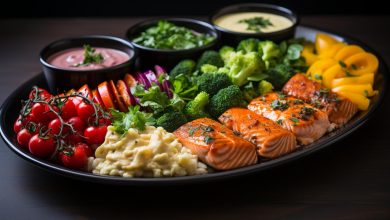Navigating Emotional Eating as a Runner

Imagine being a runner, effortlessly gliding through the miles, feeling strong and empowered.
But in the background, there’s an emotional battle brewing that threatens to derail your progress. Emotional eating can be a slippery slope for runners, sabotaging their performance and overall well-being.
But fear not! This article will guide you through navigating emotional eating as a runner.
From understanding triggers to building a healthy relationship with food, we’ll provide practical strategies and support to help you conquer this challenge and reach your full running potential.
Understanding Emotional Triggers

You need to recognize your emotional triggers to understand why you turn to food while running. Emotional eating patterns can often arise from various triggers, such as stress, boredom, sadness, or even happiness. These triggers can cause an automatic response where you seek comfort or distraction through food. By identifying these triggers, you can gain insight into your emotions and develop coping mechanisms that don’t involve turning to food.
To recognize your emotional triggers, start by keeping a journal of your eating habits and noting down any emotions you were experiencing before reaching for food. Look for patterns in the situations or emotions that consistently lead to emotional eating episodes. For example, you might notice that after a long day at work when you are feeling overwhelmed, you tend to crave sugary snacks.
Once you have identified your emotional triggers, it’s essential to develop alternative coping mechanisms that promote healthier behaviors. Instead of using food as a solution for stress relief or comfort, consider engaging in activities like exercising, practicing mindfulness techniques such as deep breathing or meditation, talking to a friend or therapist about your feelings, or finding other hobbies that bring joy and fulfillment.
Understanding and addressing your emotional triggers is crucial in breaking the cycle of emotional eating while running. By developing healthier coping mechanisms and finding alternative ways to manage emotions during exercise, you can create a more balanced relationship with both running and food.
Recognizing the Signs of Emotional Eating

If you’re struggling with identifying the signs of emotional eating, it’s important to pay attention to your body’s cues and emotions. Emotional eating can have consequences for both your physical and mental well-being. Here are some signs to look out for:
– Eating when you’re not hungry: If you find yourself reaching for food even though you don’t feel physically hungry, it could be a sign of emotional eating.
– Craving specific types of food: Emotional eaters often crave comfort foods like ice cream or chocolate as a way to cope with their emotions.
– Eating in response to stress or negative emotions: If you notice that you turn to food when feeling stressed, sad, or angry, it may be a pattern of emotional eating.
– Feeling guilty or ashamed after eating: Emotional eaters often experience feelings of guilt or shame after indulging in comfort foods.
– Difficulty stopping once you start eating: One common characteristic of emotional eating is finding it hard to stop once you start consuming food.
Recognizing these patterns can help you better understand your relationship with food and work towards developing healthier coping mechanisms. By addressing emotional triggers and finding alternative ways to manage your emotions, you can break free from the cycle of emotional eating and improve your overall well-being.
Strategies for Managing Emotional Eating as a Runner

As a runner, it’s important to find effective strategies for managing emotional eating. Mindful eating and stress management are two key components that can help you navigate this challenge.
When it comes to mindful eating, the goal is to pay attention to your body’s hunger and fullness cues, as well as the emotions that may trigger your desire to eat. Take the time to savor each bite of food, focusing on its taste, texture, and aroma. This helps you slow down and truly enjoy your meals without overeating.
Stress management is another crucial aspect of managing emotional eating as a runner. Exercise itself is a great stress reliever, so lace up those running shoes and hit the pavement when you’re feeling stressed or overwhelmed. Additionally, incorporating other stress-reducing activities into your routine can be beneficial. These may include practices like yoga or meditation, which can help calm your mind and reduce emotional eating triggers.
Remember that everyone’s journey with emotional eating is unique, so don’t hesitate to seek professional guidance if needed. A registered dietitian or therapist specializing in disordered eating can provide personalized strategies to support you in managing emotional eating while maintaining your running performance.
Building a Healthy Relationship With Food

When building a healthy relationship with food, it’s important to focus on nourishing your body and listening to its needs. Developing mindful eating habits can help you break the cycle of emotional eating and establish a more balanced approach to food.
Here are some practical strategies to guide you:
– Practice awareness: Pay attention to your hunger and fullness cues. Eat when you’re hungry, and stop when you’re satisfied.
– Slow down: Take the time to savor each bite, enjoying the flavors and textures of your food. This can help prevent overeating.
– Choose nutrient-dense foods: Opt for whole, unprocessed foods that provide essential nutrients for your body’s needs.
– Honor cravings in moderation: Allow yourself occasional treats without guilt or restriction, but be mindful of portion sizes.
– Seek support: Surround yourself with positive influences who can offer encouragement and accountability on your journey towards a healthier relationship with food.
By incorporating these strategies into your daily routine, you can develop mindful eating habits that nourish both your body and mind.
Transitioning into seeking support and accountability will further enhance your progress in building a healthy relationship with food.
Seeking Support and Accountability

Seeking support and accountability from others can greatly enhance your progress in building a healthy relationship with food. When it comes to finding motivation and setting goals for yourself, having a support system can make all the difference.
Research has shown that individuals who have a strong social network are more likely to achieve their goals and maintain long-term success.
One way to seek support is by joining a community or group that shares similar interests and goals as you do. Whether it’s an online forum, a local running club, or even just friends who are also working towards healthier eating habits, being surrounded by like-minded individuals can provide encouragement and inspiration.
Not only can you share your own struggles and successes with others, but you can also learn from their experiences.
Accountability is another important aspect of seeking support. Finding someone who will hold you accountable for your actions and choices can help keep you on track with your goals. This person could be a friend, family member, or even a professional such as a therapist or nutritionist.
Regular check-ins and discussions about your progress can help keep you motivated and focused on making positive changes.
Conclusion
As you cross the finish line, a wave of emotions washes over you. The highs and lows of your journey as a runner have shaped you in ways words cannot fully capture.
But amidst the triumphs and setbacks, there is one constant companion that has always been by your side – food. Navigating emotional eating as a runner requires understanding your triggers, recognizing the signs, and implementing strategies to manage it.
By building a healthy relationship with food and seeking support when needed, you can conquer emotional eating and thrive on your running journey.






